This episode’s guest is Roy Yamaguchi, the founder of Roy’s Restaurants, Tavern by Roy Yamaguchi, and Eating House 1849.
Roy was born and raised in Japan but now lives in Hawaii. He is a graduate of the Culinary Institute of America and worked for famous restaurants such as L’Escoffier, L’Ermitage, and Michael’s.
He is also a television personality who starred in six seasons of Hawaii Cooks with Roy Yamaguchi on PBS. He has won many awards including the James Beard “Best Pacific Northwest Chef” Award in 1993.
I have had some of the best meals of my life because of Roy. For example, I once had a tomahawk steak at his restaurant that changed my life.
He and I get a little deep discussing local-boy eating in Hawaii. I don’t want you to miss anything on your next trip to Hawaii, so in addition to eating at Roy’s, be sure you check out Koko Head Cafe, Koa Pancake House, and Zippy’s.
And now here’s Roy Yamaguchi.
I hope that Roy and I didn’t local-boy out too much for you. When two people from Hawaii start talking about local food, it’s hard to stop. I hope you noticed that Roy, unlike Andrew Zimmern, likes spam.
The next time you’re in Hawaii–if we ever fly again, you have to grab a meal at one of Roy’s restaurants. Here’s what you should order:
Big Eye Tuna Poke
Szechuan Spiced Pork Ribs
Blackened Island Ahi
Roy’s Melting Hot Chocolate Soufflé
The most important lesson that I learned is that you should clean as you cook. That’s my new goal.
This week’s question is:
What food reminds you of growing up and home? #remarkablepeople Share on X
Use the #remarkablepeople hashtag to join the conversation!
Where to subscribe: Apple Podcast | Google Podcasts
Learn from Remarkable People Guest, Roy Yamaguchi
Izakaya Nonbei https://www.izakayanonbei.com/
Koa Pancake House http://www.koapancakehouse.com/
Zippy’s https://www.zippys.com/
Like Like Drive Inn https://likelikedriveinn.com/
Culinary Institute of America https://www.ciachef.edu/
Follow Remarkable People Host, Guy Kawasaki
I’m Guy Kawasaki, and this is Remarkable People. Mahalo to Jeff Sieh and Peg Fitzpatrick who are the melting hot chocolate soufflés of podcasting.
Guy Kawasaki:
Enter your name and email address below and I'll send you periodic updates about the podcast.
I'm Guy Kawasaki and this is Remarkable People.
This episode's guest is Roy Yamaguchi, the founder of Roy's Restaurants, Cavern by Roy Yamaguchi, and Eating House 1849.
Roy was born and raised in Japan, but not now lives in Hawaii.
He is a graduate of the Culinary Institute of America and worked for famous restaurants such as L'Escoffier, L'Ermitage and Michael's.
He is also a television personality who starred in six seasons of Hawaii Cooks with Roy Yamaguchi.
He has won many awards, including the James Beard Best Pacific Northwest Chef in 1993.
I have had some of the best meals of my life because of Roy. Oh my god! For example, I once had a Tomahawk steak at his restaurant that changed my life.
He and I get a little deep discussing local boy eating in Hawaii. I don't want you to miss anything on your next trip to Hawaii, so in addition to eating at Roy's, be sure you check out Koko Head Café, K-O-K-O is how you spell Koko, Koa Pancake House, K-O-A is how you spell Koa, and Zippy's.
I'm Guy Kawasaki, and this is Remarkable People, and now here's Roy Yamaguchi.
Roy Yamaguchi:
I was born and raised in the Pan on a US army base. So I was brought up with a lot of GIs and military family.
And then, because my father was from Hawaii, born on Maui, but ended up in Okinawa, he married my mother and moved to Japan. But since he was civil servant, and not a really career military man, he was able to be stationed in Japan for a long time. So he was born and raised there, US military base, and then one day I took home EC in high school.
Guy Kawasaki:
You took home EC in high school?
Roy Yamaguchi:
I took home EC in high school.
And I had invited my school counselor for this lunch that I had prepared, roast turkey and stuffing.
So goes "Hey Roy, what are you going to do for the rest of your life?" So I said, "I'm not really sure". He goes, "After eating your turkey", that I had made, he goes, "Hey you may have a career in cooking".
Guy Kawasaki:
Really?
Roy Yamaguchi:
Yeah. So he goes, "I want you to come to my office, in New Haven." Back then it was in New Haven, Connecticut. I had just moved to New York, in Hyde Park, upstate New York. "And if you want to go, we'll see what we can do." So I said, "Yeah, why not!".
He did most of the paperwork and went to some teachers that I had and I said "Hey, I need some recommendations letters" and put it all together and applied for the Culinary Institute of America, CIA, and actually they were full so I got declined.
So my father goes, "Hey Roy, since we are applying from Japan, why don't you apply as a Japanese citizen?" I said, "Okay.”
But anyways, to make the long story short, I applied and got in. And then I spent a couple of years in upstate New York in this culinary, a great school. It's like the Harvard of cooking school and it's the best cooking school in the world. I went there. I graduated and ended up in Los Angeles and started working in different restaurants.
Guy Kawasaki:
Did your parents, obviously I'm Asian-American, you're Asian-American, they didn't get disappointed you didn't go to college, you didn't become a doctor, a lawyer, a dentist, you became a chef? It was cool with them?
Roy Yamaguchi:
You know what, I'll be honest with you. My dad was, because when I was maybe a sophomore in high school and stuff, I was thinking about, really just moving from Japan and just going to Los Angeles and going to a trade school. And there was a school called LACC, LA City College. So, I was going to go there, when I told my dad I was going to cooking school, he just said "Hey, let's just go".
I was going to do something else, other than go to a city college and not know what I was going to do for the rest of my life, so he said, "Hey, if you're focused and doing something like cooking..."
But, on the other hand I have to tell you because back in the early forties, my grandfather owned a restaurant in Maui and my father had worked helping him when he was a child, so he kind of knew the restaurant business, and my father loved to cook so I think that with all of that in mind, he was very very happy that I actually pursued cooking, because that was my father's love.
After work, my father would come home after a hard day's work, and my mother would have some Japanese tsukemono or some sunomono, pickled cucumbers and stuff like that on the table and my father would sit there and read the paper and have his beer.
And after that he would start making dinner for us right, so cooking was in the family, and my grandfather, same thing. When I used to visit my grandparents on Maui during the summertime, my grandfather would take us and go to the different farms, I don't know where these places were because I was really young, but all I know is that he would buy a chicken, and he plucked the feathers and drained the blood and all of that stuff and that night, he would have chicken tikka.
And that's the way we were brought up, so I think my father was extremely happy.
Guy Kawasaki:
Oh, that's good.
Roy Yamaguchi:
Plus, I would have never made it as an attorney, I didn't have the brain.
Guy Kawasaki:
I went to law school for two weeks and quit.
So, at the age of nineteen you were already a master chef from CIA?
Roy Yamaguchi:
Not at all, not master chef.
Guy Kawasaki:
How does it work?
Roy Yamaguchi:
So what happened was at the age of nineteen I had art, so I started cooking school when I just turned eighteen, it's a two year school to get an AOS.
So I spent two years at school, when I graduated from cooking school I was still nineteen years old. And you get a degree, you get an AOS degree.
At that time, I was just starting out. I was just a cook. I mean it can be a chef but I would consider myself more of a cook because when you go to cooking school you get the foundation. That's a building block to me, from there on, you can step up.
I was fortunate enough to graduate from CIA. And then I got a job in different places but the first place I got a job was at this country club, the La Country Club, and I was working on their buffet line serving stewed tomatoes and beef stew.
And then at the same time I was working at the Beverly Hilton Hotel, and luckily, I got a job on the top floor at the L'Escoffier coffee room French restaurant, peeling potatoes and making green beans into string beans.
They put the green beans into this little machine that you can't hand crank, and it comes out like a string bean.
Anyways, did that, but after a couple of months I got fired from both places because they said that I had replaced somebody that came back so they didn't really need me anymore.
In the Country Club, they said the same thing, that the person that I filled in for is back to work again so sorry we don't have a place for you.
Guy Kawasaki:
What year is this?
Roy Yamaguchi:
That was in 1976.
Guy Kawasaki:
So it wasn't World War II or anything obviously?
Roy Yamaguchi:
Yeah yeah exactly you know, so then I was out of both two jobs and then I took the bus and went to different places and interviewed and ended up getting a job in a Scandinavian restaurant in Beverly Hills, and that was a trip. It was it was pretty cool, but you know, things happen and you learn different types of other cuisines, so it was good.
Guy Kawasaki:
So along this journey, do you have heroes? What chefs inspired you?
Roy Yamaguchi:
I've been very fortunate because when I was at CIA there was two instructors or should I say, more in administration, but there was a gentleman by the name of Joseph Amendola, who was a baker. And he was one of the vice presidents for the school and Leroy Folsom, who was also in the administration but he's a great chef.
And these two individuals, and it's kind of crazy because when I was at school there was three Japanese guys in the entire school, and we all got a dorm together. Crazy right? What a coincidence.
So there's one dorm, but these two other guys were older and they had traveled a lot and cooking wasn't their thing, but they just, I don't know, ended up in cooking school.
I had gone to cooking school to become hopefully a chef or to advance in the cooking world. I was kind of housed with them. We had nowhere to go. I mean, I had nowhere to go because I didn't have any money to go anywhere other than stay in my dorm, but they had gone to Washington DC, because they were from DC earlier, before going to CIA.
I stayed in the dorm but these two gentlemen, Mr. Folsom and Mr. Amendola, invited me to their house. And they would say, "Okay, why don't you come for Christmas or Thanksgiving, and you can be with our family, but you have to do one thing, and that is to help us cook.”
I would get a task, like he would say, "Okay, why don't you cook mashed potatoes, or help make the mashed potatoes?" And wow I was overwhelmed because I thought to myself, "Well this is pretty cool stuff". But still at the same time, I had to perform, right?
You know, I had to make mashed potatoes in this gentleman's house and he's one of the big wigs of the culinary, and he had written a bunch of books for the culinary. And that's how I used to spend my holidays, spending time with these great chefs.
And one day, Duke Folsom goes, "Hey Roy after you graduate, what are you going to do?" I said, "I don't know, I'm going to go work in a French restaurant, I guess". Then he goes "Why French?" I said, "I don't know I mean sounds pretty good, right?" He goes "No, whatever restaurant you think can give you a lot of happiness, you should pursue. Not just French but any type of cooking".
So these were gentleman's that have really helped me, and really mentored me in a different way, way back when I was nineteen or eighteen years old.
And then after that, I worked in a lot of different restaurants. I would have to say that my biggest impact was at L'Ermitage. I had worked in this French restaurant, because you know I was, again-
Guy Kawasaki:
That's a big deal, right?
Roy Yamaguchi:
Yeah. I was like "Wow, man".
L'Escoffier was French, but yet it was it was more of a manufactured restaurant, whereas L'Ermitage was really really personal.
The chefs Jean Bertranou and Michel Blanchet, they were all great individuals, they were real warm and they wanted to help you work with you, and they would show me things with their hands. They would help develop me from just being a walk-in cook.
And when I left there I was a sous chef, I was an assistant chef.
But they're the ones who really molded me. When I did something great, they praised me, but even the chef owner Jean Bertranou, who used to work side by side with me on a busy night would tell me, "Hey, this and that and this and that and this and that", and it was some cool stuff.
And their colleagues, their friends were all the great chefs from France. Chef Bocuse, Visagie, Thiago, Mark Menno all these great chefs from France, where were these guys are buddies, and they would come to L'Ermitage to cook.
So I have to say that when it comes to cooking, these were my mentors, and of course, my dad was always a gung ho type of guy. My dad and I really didn't see eye to eye when we were growing up, but at the end of the day, my dad was a hard worker, extremely hard worker. His whole thing was work work work work work work work work work work then play, play, play, play, play. But work was really extremely important and he instilled that "Hey man, if you don't work, you're not going to get nothing out of life so you better just dive into it and put your head down and just take the lickings and just go for it".
Guy Kawasaki:
When you see these TV specials about Gordon Ramsey ripping everybody, what do you think?
Roy Yamaguchi:
Hey, that's the real world, man.
Guy Kawasaki:
That's how it is?
Roy Yamaguchi:
At the end of the day, circumstances, to me, are extremely important. And timing is extremely important.
To me, when you're teaching somebody, there's two ways to teach, right? Of course, with hands-on, you nurture someone. But at the same time, when someone does something wrong, you have to let them know.
Time is the of the essence. And if something sucks, I mean, you have to let them know that it sucks, it is not acceptable. You can't take eight hours to explain to someone "Hey listen, this is not acceptable, start over again".
And I was taught, in a way, like in a Hell's kitchen environment. That's the way that I was taught. Hey, listen, if it's no good, it gets thrown away. You start over again. There's none of that “hold your hand and say, ‘You got to make it better.’” It’s more like “This sucks. There's people waiting at the table for a great meal. And if you can't produce it, we have got to find somebody else to produce that meal.”
So I can understand that.
And at the same time, believe it or not, Gordon Ramsay is an incredible human being. He is a very, very personable, caring individual.
Guy Kawasaki:
But--
Roy Yamaguchi:
No, no, no, no. I'm just saying. It's under the circumstances of TV, and maybe I'm not sure. I've never been in his environment in a restaurant. I've been in a show with him and stuff, but I never been in his restaurant where he's commanding and stuff. Maybe it could be different. I don't know.
Guy Kawasaki:
Is that how you are here?
Roy Yamaguchi:
No, no, I used to be a lot more aggressive in the kitchen, because I understand.
Listen, at the end of the day we're all about time. It's all about time because if you can't produce fast enough people get angry. It doesn't matter how great food is, you have to do it in a timely matter. And you have to set the tone.
There’re people that have been anxiously waiting to have dinner. And of course, you have to pace it, right? People don't want to be rushed. But at the same time, they can't wait forever. So, we in the kitchen have to observe that and know that our customer, our guests are here to have a great experience. But we have to make sure what is that? We have to be able to read that and say to ourselves, “Okay, what does that guest really want?”
Is it more time, less time, perfection in the meal, great service, what is it? So if we want to deliver all of that we have to understand that, and then be able to deliver that in a timely fashion, greatness in a timely fashion.
Guy Kawasaki:
How does one go about winning a James Beard award?
Roy Yamaguchi:
The James Beard award is like the Oscars in the cooking world. And I guess there's a bunch of so-called individuals that are in different cities that would nominate you. And after the nomination is there, there's a bunch of other ones that might write in, whether it be professionals, or whether it be individuals that dine a lot or gormandize in different cities. And things have always changed and are ever evolving in that type of business when it comes to nominations and stuff.
Like back in 1995, or something, is when I won the James Beard award. I was the first recipient of the James Beard award for Hawaii.
And today, there's only been three award winners. Myself, who was the first, and then chef Ellen Wong, and chef Marvel. The three of us have won the James Beard in Hawaii. And hopefully, there'll be more.
But what I wanted was this shift Pacific Northwest, and then Hawaii, and then later on they threw California in there so it became a little harder, or a lot harder to get the award.
And now it's, I think back to California, back to Hawaii, and I think Washington and Oregon. The northwestern stuff.
Hopefully, there will be more James Beard award winners from Hawaii, because there's a lot of great talent in Hawaii. Hopefully we'll be able to see more.
Guy Kawasaki:
And when you win an award like that, does life change? Does your restaurant immediately become immensely popular?
Roy Yamaguchi:
Well the life really doesn't change. But at the same time, there's a lot more recognition. And it's recognition from your colleagues and your peers.
So it's a great award because then, when you win the award, it's like them saying, “Hey listen Roy, you know what, you've done great work. And we want to tell everybody that you've been doing a lot, a lot of great work. And we want to make sure that we substantiate that by letting people know. So you get the ribbon and with that, of course you have to maintain.”
Because you just can't win it and walk away or something, because when you win that award, there's a lot of pride that goes into it. You want to continually do a great job. You get recognized for the outstanding work that you've been doing. It substantiates all the great stuff you've been doing.
To me, it was more, because I didn't get the chance to go to the James Beard award gala when they nominated me. And when they gave me the award, I wasn't there to receive the award. I wish I would have had the chance to at least go on stage and grab the award or something.
But anyways, it's been great, because a lot of people will say, “Hey, I didn't know you're a James Beard award winner.” Because you can get nominated, and there's a lot of nominations, but to really actually win the award, there's there's not that many, right? Every year, I take it with pride, and I take a lot of goodness with it.
Guy Kawasaki:
How would you describe your style of cooking? What would you call it?
And then, how would you explain it?
Roy Yamaguchi:
It's one of these things where if you try to explain it real fast, it just never works.
And so at the end of the day, it's a wine fusion. And fusion, when I first started, people would go, “You shouldn't call it fusion, because there's a lot of negativity in fusion.” But at the end of the day, it's all about learning cultures.
I was born in Japan, learning Japanese culture, the American culture. And then at the same time, learning about the French and the different types of cultures that I lend my food with.
So making French sauces is was what I love to do. But at the same time as I continue to evolve, and I started to add Chinese or Korean, Vietnamese or the countries in Southeast Asia, etc.
But to me, I learned about the culture, and learned about the types of food that they wanted to make, whether it be spicy, or whether it be more on the subdued side, stuff like that.
And then when I started to kind of make my own style of cooking, which was more Japanese and French, in the very beginning and I started to add more cultures I try to understand and the end results got to be there. Meaning that you just can't start mixing things. And you know, whatever happens, happens, but to me, I have an end result.
But I try to figure out how I can get to that end result. Meaning that I want to have French sauces, I want to have a very colorful plate, as much as possible. I want to have a balance of whether it be spiciness or sweetness, a little saltiness, making sure that all the different ingredients I put in there becomes round, meaning that there's a certain flavor that I want to achieve.
And if it's a sauce, at the end, I want to make sure I get there.
So at the end of the day, that's called Hawaiian fusion, because I want people to have a Hawaii state of mind. But yet I can call it Euro, Asian, or whatever.
Eating the Asian flavors with the French sauces, and the Hawaii state of Mind.
And then at the same time now, because of the Hawaii regional cuisine movement, I want to make sure that I try to add as much local ingredients as possible.
Sometimes it's not 100 percent possible only because the amount of business the restaurant might do, and the amount of ingredients we need for a certain dish.
But some dishes could be 90 percent local ingredients, some could be 100, some could be 50, depending on the type of dish we want to make, and because some of the times a guest may be craving for scallops, right? And there's no scallops in Hawaii. So in order to have a scallop dish, which is the main item, naturally, it can't be 100 percent Hawaiian or local ingredients.
Depending on what we want to accomplish, is dependent on what we use, so at the end of the day Hawaiian fusion, Hawaiian state of mind, local ingredients, but yet French and a lot of Asian cultures in extent.
Guy Kawasaki:
How does it go from an idea, to the menu? Is there testing?
I can tell you how that's done in tech.
How does it go from, I want ribs and--
Roy Yamaguchi:
At the end of the day, what happens is I can visualize a certain dish, and I can visualize what I really want. So I say to myself, “Okay, I want to make a salmon dish” or “I want to make a beef dish” or “I want to make a…”, whatever it may be.
And then I say to myself, “I want it with sauce, or no sauce.”
When I think about all these different things, I say to myself at the end of the day, “I'm going to come up with a salmon dish.” and “I want some sweetness to it.” So I'm going to add teriyaki, or I want to add some sort of a soy based, maybe sugar base marinate or a sauce. And maybe because I'm doing that, I'm going to grill it. And because I'm grilling in it, it's going to be a lighter dish. So maybe instead of rice, maybe I want some couscous or whatever it may be.
Once I start thinking about all those different elements, I can visualize not only the dish, but I visualize the flavor. So I visualize the flavor, and then I visualize the ingredients that I want to have in order to make that dish. That's the way that I do it.
Then I start building the dish. I build it in my mind first.
And then after I build everything in my mind, I say to myself, “I'm going to go into the kitchen, and I'm going to start working on it.”
Sometimes it tastes like crap. “Not going to work.” So then I dump it.
Or “Some of these elements are good, so I'm going to keep some of these different elements. And then I move to the next step, “I'm going to add this, I'm going to add that, add this, add that”, and then I continue to move on.
At the end of the day, after a couple of trials, sometimes more, I end up with the dish that I want. And then after that is done, then I go to my guys and say, “This is the dish that I want to have on the menu.”
Guy Kawasaki:
From beginning to end, how long is that process?
Roy Yamaguchi:
It's kind of interesting, because sometimes it can take a day. You can have it in a day, and sometimes it'll take two weeks, and I got to dump it.
Sometimes I can work on it for two weeks. And after that it doesn't work. So I just dump it and then come back to it maybe two, three months later.
It really depends on my mood at the same time.
Guy Kawasaki:
If I looked at your menu at Roy's, January one, and then I looked at it 365 days later, how much has changed?
Roy Yamaguchi:
A lot of what we change, when we look at the ingredients, and we look at all the different things we can get, not everything would always change. But there are certain ingredients that may change because depending on the type of ingredients that we're able to get, and the type of ingredients that we want to feature during certain parts of the season. Even though Hawaii is pretty much one season, there are certain things that we can get better in certain months.
When we utilize those different items, we may have salmon, but we may have a salmon dish that may stay the same throughout the entire year. We may have another salmon dish that we may change during the season.
So taking that into account, a lot of things change.
Guy Kawasaki:
You think spam gets a bad rap?
Roy Yamaguchi:
I love spam. To me without spam for breakfast, uhm... not worth living.
I like spam a certain way. So when I eat spam, I like it a little charred on the outside. I try to cut it thick enough to where I can build the little so-called crust on both sides of the spam. So it's kind of like it has a little crispiness to it. But yet the inside is nice and moist and then put a little glaze, like a soy glaze on it. And kind of slice it and oh, it’s all right.
Guy Kawasaki:
About a month ago, I interviewed Andrew Zimmern for this. He hates spam. I think spam and maybe durian are the only two things he won't eat.
Roy Yamaguchi:
I'm not a durian fan, but I do I love spams.
Guy Kawasaki:
Do you think that social media has changed the restaurant business?
Roy Yamaguchi:
Yeah, it really has, social media has changed a lot. And it's interesting, because at the same time, it's like with these reality shows, it has really changed Chefs, I guess, status.
And because at the end of the day, I think these reality TV shows, whether it be Top Chef or Hell's Kitchen, or all these different shows that’re out there.
I think they've done a lot of good, but I think that it has also given some chefs false, I guess... They think that they can go on TV and become a world-renowned chef, or they think that it gives them a status that can't be beat.
But what happens a lot is that the chefs, the good ones, they go on TV, they do a lot of great work, and they become winners, and they can produce great food. Right?
So they go into the restaurants, because a lot of times with these TV shows they get backers, they get people that want to back them up, and put them in restaurants and stuff.
But owning your own restaurant and being on a TV is two different things. When you own your own restaurants, you have to produce profits, you have to manage people, and you have to make sure that at the end of the day, there's great food that the public wants, and people leave happy.
To go on TV show is one thing. So you get other national reputation, recognition. And sometimes when they open their own restaurant they can't cook.
Guy Kawasaki:
In the quantity that...
Roy Yamaguchi:
In the quantity, in the quality, all these different things.
So, it's kind of a false promise that they've been told that they're great. And yet, when they get into their own restaurants, they become failures.
That's why it's extremely important that you understand, or that they understand that, hey, listen, at the end of the game, at the end of the day, the game is, if you're going to open a restaurant you have to take care of your guests and you have to produce great food, timely fashion, and every guest that walks into your restaurant has to leave happy. There's no if ands and buts.
What you do on TV is one thing, but what you do in the restaurant kitchen is far more important.
Along with that the social media is, the old days used to be you open a restaurant, you make good food, I'm talking about when I first started in this industry like forty years ago. All the great restaurant forty to fifty years ago, a lot of great restaurants like L'Ermitage, L'Escoffier Room, the Rex restaurant in LA, Le Francais in Chicago and Wheeling, they make great food? No social media. No nothing. Just great food. And people write about it and people flock, and if you don't do a good job, people stop coming.
But anyways, today it's interesting because social media really attracts different types of people into different restaurants. And it's a different way to get different types of people into your restaurants.
I'm not a pro at it and I don't consider myself anywhere near knowing what I'm doing, but it's interesting how you can attract different types of people into your restaurants at different times. And it's a different way of approach of getting people to consider you as a dining experience.
Guy Kawasaki:
Have you changed the menus so that the food photographs better, have you changed the lighting, have you done anything like that consciously because of social media?
Roy Yamaguchi:
I'll be honest with you, for myself, no. Only because we've been very fortunate because some of the restaurants that we built recently, the lighting has been... People tell me, “Hey, listen Roy, not sure if you ever thought about this, but you know what, your lighting in this restaurant is incredibly good for people to photograph food.” I said “Yeah”, but it was all done by mistake.
Guy Kawasaki:
It's better to be lucky than smart.
Roy Yamaguchi:
I got lucky at all those different things. It's extremely important for people to photograph food today in restaurants.
I would have never thought that when I first this industry that people, number one, that people would be taking pictures food at the table, more or less, just taking so many pictures and making albums and sending them out to different people as they eat. I mean, it's incredible.
Guy Kawasaki:
Does it offend you as a chef that, what are these people like...
Roy Yamaguchi:
I'll tell you, the answer is no and I tell you why. I'm here to make sure that we provide our guests with memorable experiences. That's all we can do. At the end of the day, if we can't provide our guests with memorable experiences, we're not going to be in business.
We want to make sure that our guests are having a great time when they eat. And today, taking pictures and being involved and engaged in a conversation with people that they're not with as they eat, it's part of their dining experience. That's how they create happiness for themselves. So if they're happy I'm happy.
Guy Kawasaki:
Okay.
Roy Yamaguchi:
Because if you're not happy, you're going to come back, it’s as simple as that.
Guy Kawasaki:
Okay.
What's your opinion of the food truck movement?
Roy Yamaguchi:
If I were to probably do it over again, I would just have a bunch of food trucks running around.
Guy Kawasaki:
Really?
Roy Yamaguchi:
Listen, when you think about the investment that we have to make as a restaurant building, it's extremely expensive, it's a huge investment to create something that we think that could be last forever. Sometimes it doesn't.
When you get a food truck, you can give that experience. I'm talking about the end result. I'm talking about the experience as a guest. Sometimes the guest doesn't need the entire 100 yards. If you're happy with a little portion of happiness, and you can get that through a food truck or you can get without a building and mortar, you can just get that through a little something that you do.
I wouldn't go as far... I was kind of exaggerating. I wouldn't go as far as owning just food trucks. But I think food trucks is a great venue to get people to really show their characteristics and their talent.
Guy Kawasaki:
If you were advising someone who wanted to be a chef, would you say start as a food truck, test it, and then go brick and mortar?
Roy Yamaguchi:
To be honest with you, food truck to me...
There’re two things, food truck or to be the kind of a chef to promote yourself to do gigs at people's houses. Those things are pretty cool.
This Netflix thing one time on television, there was this couple that ended up having a pop-up in their own apartment. But what they did was, every Saturday night, they would have enough for 12, 10 seats or something. And they would cook, she would take care of the serving and he would cook, and they would have this dinner. And that became bigger. So once a week became twice a week. Sooner or later they decided she would quit her own job and work at it full time, and they started doing more dinners at home and at the end of the day they ended up opening a restaurant.
Guy Kawasaki:
Last night, literally last night. I don't know how my wife found it, but we went to a home on Diamondhead. It was a Korean woman, and it was seven of us, and three more people. She has 10 workstations, 10 blocks, and 10 knives. We made spam musubi, coconut shrimp, poke. And then we sat down and ate.
Roy Yamaguchi:
Oh.
Guy Kawasaki:
And it was a great experience. It's much more participation and conversation, it's really an event. It's Hollywood but it was very fun.
Roy Yamaguchi:
So those are, again, when it comes to providing memories. If you have a great memory, that can attach yourself to the next thing that somebody wants to do.
So somebody can start off by doing these things at homes or whatever it may be, and it can translate to a business later on in the future. And at the same time for a guest that goes to these things, and they have a great experience, they may say “Oh wow. If you open a restaurant, I would go to your restaurant wherever it may be. “
Guy Kawasaki:
Sure.
If you could have dinner with three people, who would they be?
Roy Yamaguchi:
Three people?
Guy Kawasaki:
Any three, alive.
Roy Yamaguchi:
Three people, alive. Oh man, that's always a hard one.
One would be you. I've never had dinner with you, so we can fix that. I've always made arrangements for you.
Guy Kawasaki:
I know, I've had some great meals without you.
Roy Yamaguchi:
But you know what, I'm a type of guy that, I'm really low key and I like to have fun. So I like to eat with people that I can have fun with, so probably like a comedian or something.
Guy Kawasaki:
Okay. Okay.
Two more questions for you alright. So, on O'ahu, where does Roy go for breakfast?
Roy Yamaguchi:
It's interesting because most of the time I go to Koa Pancake House in Hawaii Kai.
Guy Kawasaki:
Koa Pancake House in Hawaii Kai?
Roy Yamaguchi:
Yes, Hawaii Kai.
I usually get there between 6:30 and 7:00 o'clock, and I have my Denver omelet and fried rice.
Or I go to Zippy's Hawaii Kai, and I get the takeout. And I still eat it there but it's a takeout. Large Simon.
Guy Kawasaki:
For breakfast?
Roy Yamaguchi:
For breakfast, eight. Simon for breakfast is the thing. Or I get the spam. Or I go to Likelike Drive Inn, and when it opens, and I have a large bowl of Simon.
Guy Kawasaki:
I think I'm two for three on this trip already. The first stop we made was Likelike. And the only reason why we went to Likelike first is because Koala O'ahu was shut down. Broke my heart.
So now, where does Roy go for lunch?
Roy Yamaguchi:
Lunch is hard because I hardly ever eat lunch.
Guy Kawasaki:
Okay.
Roy Yamaguchi:
Lunch is something that I don't really do because I come to work, I try to have breakfast, a small breakfast, because I don't eat breakfast every day. I just have breakfast once in a while, maybe once a week or twice a week. After that I come to the office, and once I come here, I don't leave.
Guy Kawasaki:
Okay.
Roy Yamaguchi:
So that's hard.
And then, if you asked me for dinner, I live in a Diamondhead area, and I don't like to drive too much when it comes late, so I catch Uber and stuff. Ride sharing. But I like Izakaya Nonbei.
Guy Kawasaki:
What, where is that?
Roy Yamaguchi:
Izakaya Nonbei is on Honolulu street. It's across from the Safeway shopping center there on Kia'i Moku. Not Kia'i Moku but what do you call it, Kawakawa.
Guy Kawasaki:
Okay, that's a first.
Roy Yamaguchi:
It's our oldest. Izakaya Nonbei, I go there. It's a neighborhood restaurant
Guy Kawasaki:
How about main street, is it main street? It's at the edge of the golf course, across the street from Zippy's on Kapahulu Avenue. Is it Main Street or? Yeah, there's one there.
Roy Yamaguchi:
For Kapahulu, you mean Kapahulu.
Guy Kawasaki:
No no it's called Main Street, or Side Street, or...
Roy Yamaguchi:
Side street, Side street, Side street. Yeah, Side Street's a great place.
Guy Kawasaki:
Okay.
And my last question. I also interviewed Martha Stewart, and I like to have a little practical tip for someone who's cooking.
What's a Roy secret, tactical, practical cooking tip?
Roy Yamaguchi:
Number one for me, whenever I cook, and I love to cook, I really enjoy cooking because to me, cooking and cleaning is very therapeutic.
To me. And I can stand in a kitchen, whether it be at home or whether it be in a restaurant. And I can stand in the kitchen early in the day and make sauces and just look at a sauce for four or five hours. And it brings me so much enjoyment, and it takes the stress out of my life completely.
But then of course when production starts, then that's a different story. Because you're fighting time and it's chaotic. When I'm cooking, it's very therapeutic and with prepping there are stages.
I have to say that, like anything, you have to have a game plan. To me, you have to have a game plan. And the game plan is that I write everything down. In the very beginning I write things down.
Guy Kawasaki:
For the meal?
Roy Yamaguchi:
What I'm going to buy, what I'm going to get and once I get all of that done, I put all the ingredients all lined up. And then I start cooking.
And then as important as it is to cooking, cleaning is important. I clean along the way. As I take one thing and make one thing dirty I always wash it. I don't have a huge mess because a mess to me clogs up your mind. I want to make sure that the stove is clean. You don't have all these pots and pans that are laying around, you don't have all these dishes that are dirty, that's piling up in your sink.
As you cook, you clean. You get the ingredients. You chop. For me it's zen.
And then wherever you make taste it. I see so many people mixed up, they don't taste it. And especially home cooks. Home cooks always go by their recipe. You have to understand recipes are not a bible. Recipes are a guideline to what you want to do because depending on the size of the pot, depending on whether it's a ten-inch pan or a seven-inch pan, it's going to make a difference on how things reduce and how things cook. Depending on how many ingredients you have in a pan, whether it's electric or gas or if it's on ten or if it's on two, all of these things would change the outcome.
So you can't go by recipes. Use it as a guideline, but you have to use your heart, and you have to use your eyes to see what's happening.
You see all of that, and you got to make it joyful. It can't be a task. Even when I cook for 1,000 people, it's not a task.
I enjoy it. It's my life, it's fun.
When you get all of that, and you cook and clean and you taste everything and you make sure that you're washing things and adding things you taste, then it becomes enjoyable.
Because what happens is, it's the journey that you're on. Instead of start and finish, you're carving your way from A to Z. You're cooking, you're tasting, you're adding things, you're looking, you see things.
As you keep on going. You get the final result.
And when you get the final result you say, “Hey, that was a great journey. Instead of just speeding through the mountains and everything else and you get there and you go, “Hey, I'm here.” And then you go, “Ah, right.” But enjoy that ride man.
Guy Kawasaki:
If I went to Roy's house on Diamondhead. Do I see … Is your kitchen wolf ranges, sub-zero, refrigerators, its like an amazing Architectural Digest kitchen?
Roy Yamaguchi:
No, no.
My kitchen is very very simple. Matter of fact, I bought the house and I never remodeled it. And then whatever I want to use my wife always tells me, “Put it in the garage, put in the closet” or “Take something out and put it back, don't leave it there.”
Guy Kawasaki:
Really? Does she ever cook?
Roy Yamaguchi:
Matter of fact, she doesn't really cook.
Well she cooks, but last night she was making Mochi, for the New Year.
Guy Kawasaki:
For New Year's.
Roy Yamaguchi:
Yes, for New Years.
Guy Kawasaki:
Pounding the whole thing?
Roy Yamaguchi:
No she puts it in the machine.
I make food.
My whole thing is about; you don't need expensive gadgets to make great food. It helps to have certain machineries and certain technology, of course.
But to me what makes a great meal is your heart. Your heart. And it's you.
Why do people think... Well there's two ways. To me, my mother and my father, both passed away, but their food was the greatest. And why is it so great? A lot of love, a lot of love, a lot of feeling into the food. And then, some people were, “Hey, my mom and my dad's cooking were the worst.”
Guy Kawasaki:
My mom made the best Tecalitan in the world.
Roy Yamaguchi:
See, I mean there's certain things that your parents made that you really love. And some of it is because it's great, it tastes great. But some of it is because there was so much feeling into it, and it just makes that dish so much better.
I remember a lot of great things that my dad made. My dad would make beef stew, because his beef stew was more Hawaiian, or a local style. Tomatoes, broth and it may thicken it up, potatoes...
Guy Kawasaki:
Tuft's stew meat to soften it up.
Roy Yamaguchi:
Yeah.
But then, he would make that first big pot, big pot. And then the next day he turned that damn thing into a curry.
Guy Kawasaki:
From a stew to a curry?
Roy Yamaguchi:
He just threw the Korean Japanese curry blocks in there, the curry paste in there, and curry the next day man, it was great.
Guy Kawasaki:
When my mom made stew, which I was going to say is also the greatest stew I've ever had, it was a big treat for us. If she made dumplings out of this Bisquick and put it on top of the stew, that was like a big deal. Those are the days, I'm from Cali valley, so...
Roy Yamaguchi:
Yeah, okay that's great stuff.
So there's foods that you always remember as a kid that your parents made, and it's one of these things that are just go-to foods and my mother made this…she's from Okinawa, so she made these green beans with bacon, and she had eggs in there, and she had miso in there. Man.
Guy Kawasaki:
Did she make donuts?
Roy Yamaguchi:
Andagi, she used to make on Andagi. Fry that damn thing. They'd be hard as hell. You can throw it against the wall and crack the wall. But it was great, right? It tasted great, and those are things that you never forget.
Guy Kawasaki:
Oh man.
Roy Yamaguchi:
My mother will make Andagi and oh.
Guy Kawasaki:
I hope my kids talk about something that I made for them someday.
Roy Yamaguchi:
My dad had this teriyaki thing, teriyaki mix that he put in this jar, and the base of it he made when I was probably really really young. And when I left home. It was still the same pot.
Guy Kawasaki:
Really?
Roy Yamaguchi:
Same pot.
Guy Kawasaki:
Like yeast?
Roy Yamaguchi:
It's just what he would do, he would keep on adding to it. And once in a while he dumped it in a pot and bring it to a boil and stuff. But that damn thing he kept going for like sixteen to seventeen years. But that was his teriyaki sauce, so he dumped your meat in there and chicken and you grill it, unbelievable.
Guy Kawasaki:
My happiest memories were going to Ala Moana beach park, with a little hibachi, and beef teriyaki skewers.
Roy Yamaguchi:
Right on.
Guy Kawasaki:
With my mum's musubis. My mum's musubis, which she hand shaped into perfect triangles, not one of these plastic stamp jobs. Oh my god. And ume, and her tacoane.
Roy Yamaguchi:
When I was a kid, we’d go on field trips or something, and my mom would always make me sandwiches in Japanese white bread. She'd make me tonkatsu sandwiches, whether it be with the pork tonkatsu sandwiches, and then she'd make me musubi. Then she'd make me a fried chicken. Oh!
Guy Kawasaki:
I hope that Roy and I didn't local boy out too much for you.
When two people from Hawaii start talking about local food, it's hard to stop.
I hope you noticed that Roy, unlike Andrew Zimmern, likes spam.
The next time you're in Hawaii, if we ever fly again, you have to grab a meal at one of Roy's restaurants.
Here's what you should order; bigeye tuna poke, Sichuan spiced pork ribs, black and island ahi, Roy's melting hot chocolate souffle.
That you have to order in the middle of your meal because it takes a long time to make that.
The most important lesson that I learned from this interview is that you should clean as you cook. That's my new goal.
I'm Guy Kawasaki, and this is Remarkable People.
Mahalo to Jeff Sieh and Peg Fitzpatrick who are the melting hot chocolate souffles of podcasting.
Be healthy, be safe.
Mahalo and aloha.
This is Remarkable People.
Sign up to receive email updates

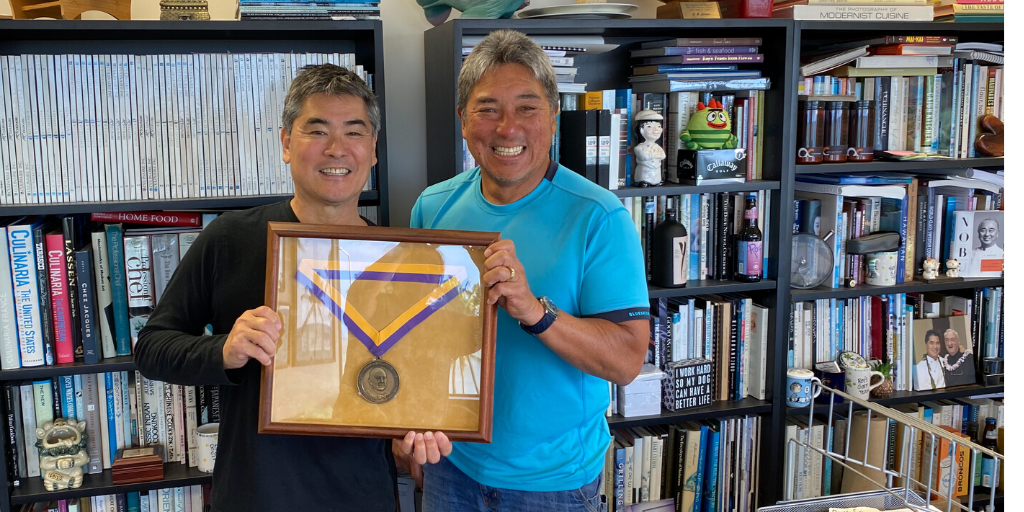
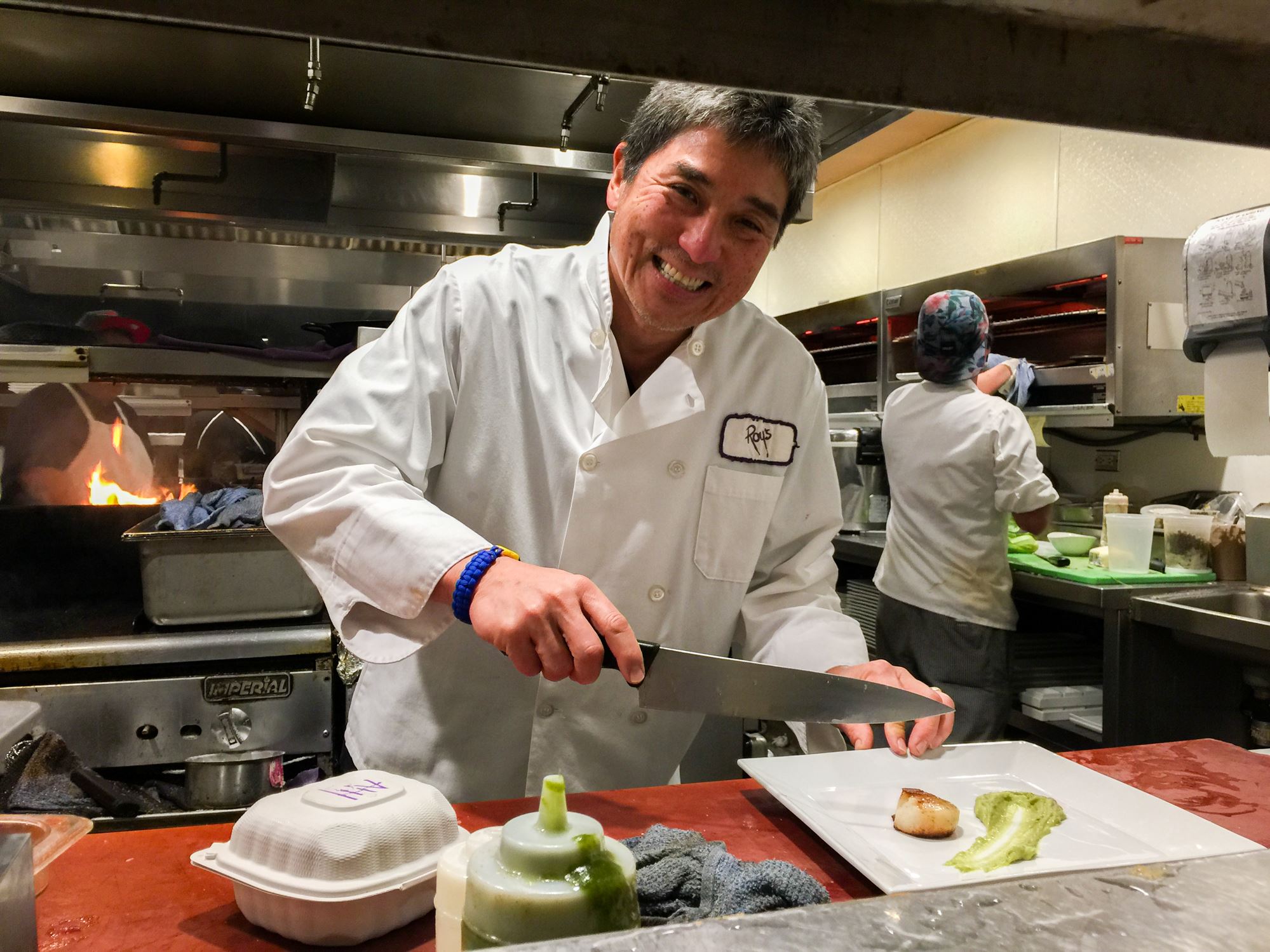
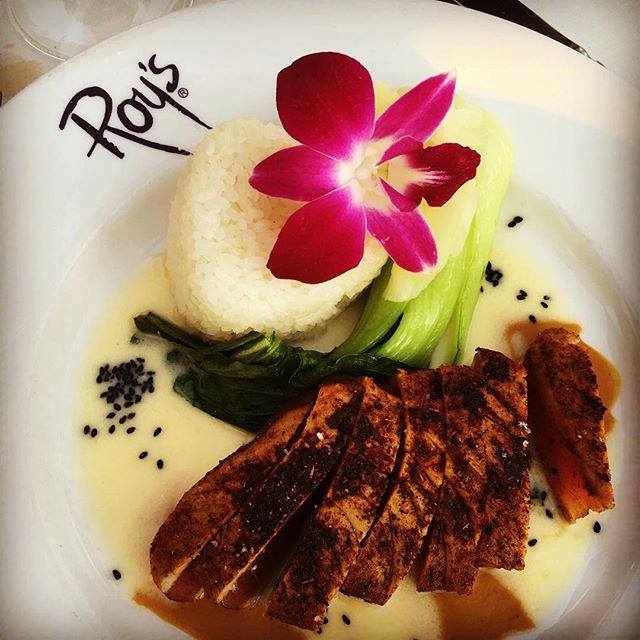
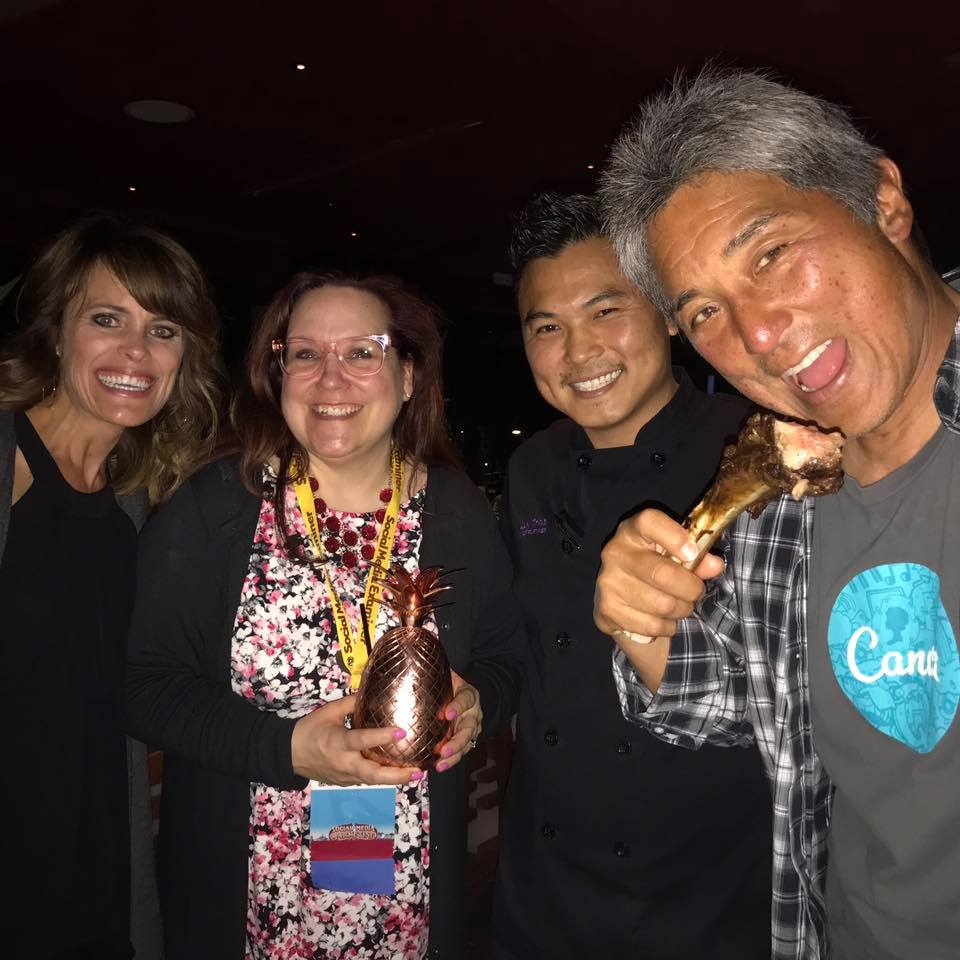
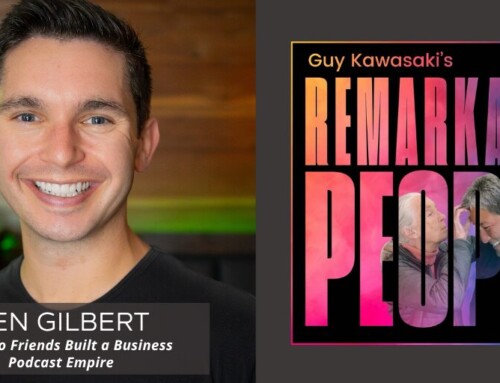
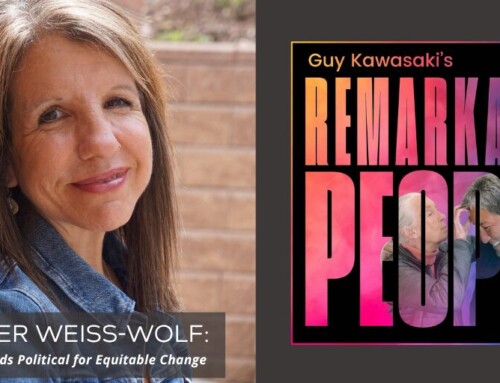
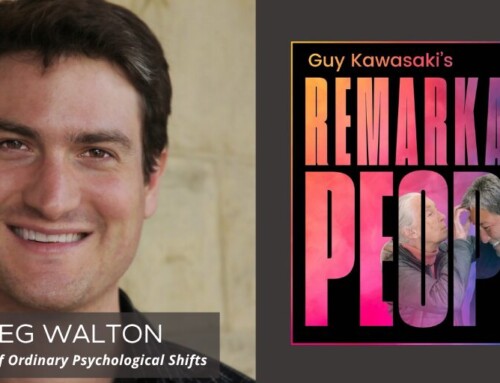
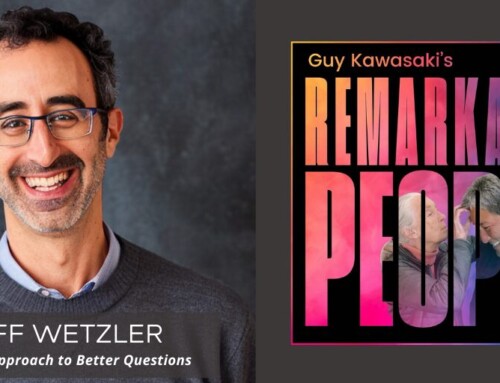
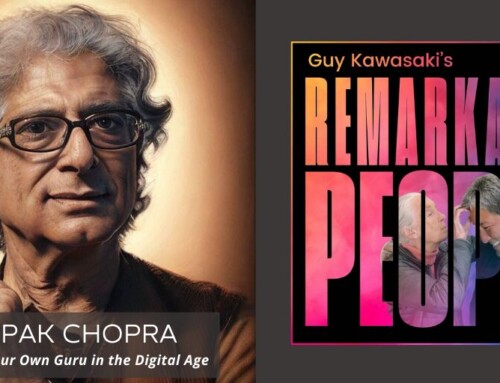
I love Roy’s food! Years ago, we had our wedding rehearsal dinner at Roy’s Grill in the Poipu area of Kauai. Our wedding was on Halloween. When they asked me what I wanted for the dessert, I told them that I love pumpkin and I encouraged them to have fun and create what they wanted. Their team made these amazing pumpkin tortes with chocolate drizzled on it to look like spider webs and a chocolate spider! What a fantastic treat and dining experience. Thank you, Roy! Thank you, Guy, for interviewing him. Mahalo!